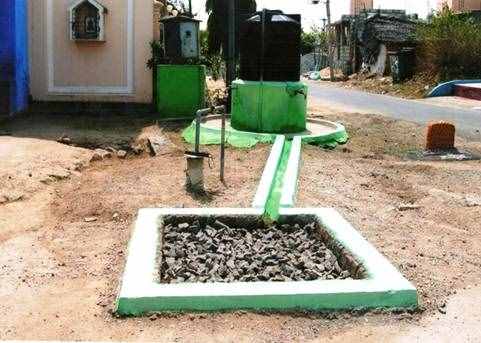Top 5: Cities In India for Rainwater Harvesting (RWH)
 Rainwater harvesting RWH
Rainwater harvesting RWH
Rainwater harvesting (RWH) is India’s ancient wisdom that has been in practice for at least 4000 years. The practice of saving rainwater goes back to the ages of Indus Valley Civilization where the city of Dholavira in Gujarat. The city continues to serve as a model for water management in the country even today.
The demand for water is rising and come every summer, every city and taluka of the country faces water scarcity. This is not just hampering the quality of life of the people but also the coming generations. Rainwater harvesting system provides an immediate solution to save the future of mankind. But the travesty is that despite having strict laws mandating rainwater harvesting in the metros and Tier-II cities, their implementation is next to worse.
According to an estimate, if just a third of rainwater in an average Indian city is harvested, the city will not need any other source for water throughout the year. Of late, few cities have successfully implemented the policies of rainwater harvesting with the support of its residents. They serve as a role model for other cities as to how situations can be transformed one from water scarcity to water abundance.
A good rainwater harvesting system enables ground water recharge using Recharge Pit, Trench, Open Well, Dug Well, Shaft and Tube well. There can also be direct use of the saved rainwater through filters when the rainwater is collected into tanks from simple devices like roof catchment panels, gutters, downpipes, wain water/storm water drains and filter chamber. The top five cities in India in terms of rainwater harvesting are:
Chennai: Chennai has made a turnaround as far as groundwater resource is concerned in quite a dramatic way through rainwater harvesting. When the city was almost parched, the state government made rainwater harvesting mandatory for all new buildings in 2001. The city administration focused on all of its 200 wards individually, generating awareness through women organisations about rainwater harvesting. Now every spell of rain raises the level of ground water helping the supply system. Today about 2.6 lakh buildings, including houses, have rainwater harvesting systems. The success of the Chennai model can be imagined from the fact that Delhi, a larger metro, has a mere 16000 systems. In the majority area of Chennai, the ground water level is 5-10 meters below the ground and in some its between 2-5 meters.
Bangalore: The state capital of Karnataka, another metro city, follows the footsteps of Chennai and has more than 1.55 lakh rainwater harvesting installations. Bangalore Water Supply and Sewerage Board (BWSSB) led this transformation and have established a Rainwater Harvesting Model Park in the city where it demonstrates 27 models of RWH and motivates people from all walks of life to install these in their homes. It has thousands of visitors every month. BWSSB made RWH mandatory in 2009 and it doesn’t hesitate in pushing for penalties on defaulters. The department estimates that as much as 10 MLD of rainwater could be used directly by the Bangaloreans by 2025.
Shillong: Rooftop rainwater harvesting is the most common practice in the capital city of Meghalaya – Shillong. One would be shocked to know that the city is just 50-odd km away from Cherrapunji and Mawsynram that receive the highest rainfall in the world and the travesty is that Shillong faces acute shortage every year, mainly during the summer peak. Today, almost every building in Shillong has a rooftop rainwater harvesting system and every household gets around 25% water from RWH systems. Meghalaya government has created a series of tanks in the state, including Shillong that catches the rainwater through RWH systems. The rooftop RWH collected rainwater is used directly for consumption and also for groundwater table recharging.
Indore: After establishing itself as the flagbearer of cleanliness in India, Indore is adamant to catch every single drop of rain and conserve it. Indore Municipal Corporation has found a significant increase in the groundwater levels even though the city adopted mandatory RWH just a year ago through Indore Municipal Corporation (Rainwater Harvesting) Bylaws. IMC now wants 1,00,000 rooftop RWH systems to be installed in Indore this year alone. Initially, the corporation began with a target of 50,000 RWH installations through awareness generation by ‘jalmitras.’
Bhubaneshwar: The capital city of Odisha is flanked by the mighty Mahanadi in the vicinity and the water availability in this segment of Eastern Ghats is immense owing to the strong Monsoon branch that pounces on it every year. Despite this, the state government is aggressive on rainwater harvesting in the entire state, with key focus on Bhubaneswar of late. ‘Catch the Rain’ campaign has helped expand the RWH structures in the city, especially the rooftop ones on the buildings. The state government has launched Rooftop Rainwater Harvesting Scheme as ‘Community Harnessing and Harvesting Rainwater Artificially from Terrace to Aquifer (CHHATA) to install 29,500 rooftop RWH systems on private buildings and around 2000 on government buildings in most of its important ULBs and water stressed blocs. Bhubaneswar is likely to be a key beneficiary of it. The government is providing incentives and technical help to owners of buildings. Now the government is looking to add 10,000 RWH structures in 75 days even though it’s a water surplus state and Bhubaneswar is expected to be the center of this campaign.
Rainwater harvesting brings a package of great benefits to our cities. Besides raising water security for urban dwellers, it reduces water run-off, reduces soil erosion and damage to plantations, storm water drains are not choked, reduces flooding or roads and there by their maintenance that translates into high social returns.




